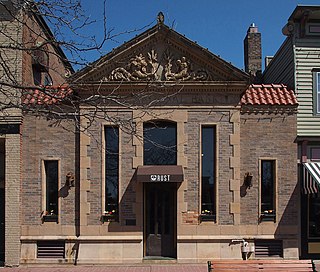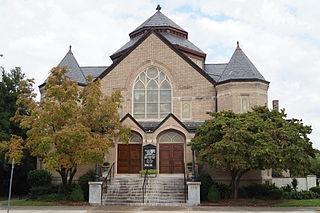
The First National Bank of White Bear is a historic former bank building in White Bear Lake, Minnesota, United States, built in 1921. It is listed on the National Register of Historic Places for having local significance in architecture and commerce. It is one of White Bear Lake's most architecturally sophisticated commercial buildings constructed before the 1940s. It also served a key financial role as White Bear Lake evolved from a resort town of summer homes for nearby Saint Paul into a full-fledged city with year-round residents.

George Washington Memorial Park is located at the center of Jackson, Wyoming. More generally known as "Town Square", the park is notable for its elk-antler arches at each corner of the park, collected from the nearby National Elk Refuge by Boy Scouts and periodically rebuilt. The square originally existed as an open space in the center of town that was made into a park in 1934. The park center also contains a stone memorial to John Colter.

The Central Square Historic District is a historic district encompassing the central town common of the city of Waltham, Massachusetts, and several commercial buildings facing the common or in its immediate vicinity. The common is bounded by Carter, Moody, Main, and Elm Streets; the district includes fourteen buildings, which are located on Main, Elm, Lexington, and Church Streets, on the north and east side of the common. The district was listed on the National Register of Historic Places in 1989.

The Wakefield Trust Company is a historic commercial building at 371 Main Street in Wakefield, Massachusetts. Built in 1924, it is one of three buildings on the west side of Main Street that give the town center a strong Classical Revival flavor. The building was listed on the National Register of Historic Places in 1989.

There are 75 properties listed on the National Register of Historic Places in Albany, New York, United States. Six are additionally designated as National Historic Landmarks (NHLs), the most of any city in the state after New York City. Another 14 are historic districts, for which 20 of the listings are also contributing properties. Two properties, both buildings, that had been listed in the past but have since been demolished have been delisted; one building that is also no longer extant remains listed.
Albion State Bank was an historic structure in Albion, Oklahoma, located amidst the rugged and rural but verdant Kiamichi Mountains, in northeastern Pushmataha County, Oklahoma.

Valparaiso has retained an active downtown. It remains a mix of government, retail and business center, with a mixed residential and service area. Numerous economic changes have not changed the basic character, historic courthouse area. The historic district retains the distinctive turn-of-the-19th-century architecture, supporting numerous small specialty shops, shaded sidewalks, and a people friendly environment. The Downtown District, is anchored on the Porter County Courthouse. It includes 14-blocks surrounding the square, bounded on the north by Jefferson Street, on the east by Morgan Street, on the south by Monroe Street, and on the west by Napoleon Street.

Wright Block is a property in Grand Forks, North Dakota that was listed on the National Register of Historic Places in 1982.

The Telephone Co. Building in Grand Forks, North Dakota, United States, was built in 1904. It was listed on the National Register of Historic Places in 1982.

The Plymouth Historic District encompasses a cluster of five civic buildings and the town common of Plymouth, New Hampshire. The buildings are arrayed on the west side of Plymouth's town common, laid out not long after the town's settlement in 1763. The 2-acre (0.81 ha) district includes the town hall/court house, the Pemigewasset National Bank building, and the US Post Office building, as well as the Old Grafton County Courthouse. The Plymouth Congregation Church also falls within the district bounds, but is not considered contributing. The district was listed on the National Register of Historic Places in 1986.

South Union Street Courthouse and Commercial Historic District is a national historic district located at Concord, Cabarrus County, North Carolina. The district encompasses 11 contributing buildings in the central business district of Concord. It primarily includes commercial buildings in popular architectural styles including Italianate, Romanesque Revival, and Second Empire style architecture. Located in the district are the Elks Hall, former Town Hall, G. W. Patterson Wholesale Grocery, Pythian Building, Watch Repair Shop, and former Cabarrus Savings Bank (1923-1924). Also in the district is the separately listed former Cabarrus County Courthouse.
Union Street North–Cabarrus Avenue Commercial Historic District is a national historic district located at Concord, Cabarrus County, North Carolina. The district encompasses 14 contributing buildings in the central business district of Concord. It primarily includes commercial buildings in popular architectural styles including Beaux-Arts style architecture. Located in the district are the Bell and Harris-Maxwell Brothers Furniture Store (1921–1924), Yorke and Wadsworth Company Warehouse (1908–1911), Lippard and Barrier Grocery (1908–1911), Concord National Bank and Hotel Concord (1926), Star Theatre, Cannon Building and Concord Theatre, and Horton Building–Commerce and Merchants Building (1952).

Queen–Gordon Streets Historic District is a national historic district located at Kinston, Lenoir County, North Carolina. It encompasses 20 contributing buildings in a mixed commercial and industrial section of Kinston. The buildings include notable examples of Classical Revival, Beaux-Arts, and Romanesque style architecture and date between 1895 and the mid-1930s. Notable buildings include the Gordon Street Christian Church (1912-1915), (former) U. S. Post Office/Federal Building (1915), Citizens / First National Bank Building (1903), (former) Farmers and Merchants Bank (1924), Canady Building (1899), and the LaRoque and Hewitt Building.

The Depot Square Historic District encompasses the historic commercial business district of Randolph, Vermont. Developed in the mid-19th century around the facilities of the Central Vermont Railway, the area features a high concentration of well-preserved Second Empire and late Victorian commercial architecture. It was listed on the National Register of Historic Places in 1975.

The Railroad Street Historic District encompasses a cluster of commercial and railroad-related buildings at the traditional late 19th-century heart of St. Johnsbury, Vermont. It includes five commercial buildings and the town's 1883 union depot, and is reflective of the town's importance as a major railroad junction in northern New England. The district was listed on the National Register of Historic Places in 1974. It was subsumed by the larger St. Johnsbury Historic District in 1980.

The Western Union Building, formerly known as the Hagerty Block and currently as the Dacotah Prairie Museum, is a historic bank building in Aberdeen, South Dakota. It is individually listed on the National Register of Historic Places and is a contributing property to the Aberdeen Commercial Historic District.

The First National Bank of Davenport, also known as Brenton Bank and The Brenton, is an historic building located in central Davenport, Iowa, United States. It was added to the National Register of Historic Places in 2018. It is significant for its associations with the history of community planning and development, and as an important example of modernistic design.

The Wakonda State Bank, later the Wakonda Public Library, is a historic bank building at 118 Ohio Street in Wakonda, South Dakota. It was listed on the National Register of Historic Places in 2003 due to being a rare surviving local example of early 20th-century architecture.

Wakonda Variety is a historic commercial building at 125 Ohio Street on Wakonda, South Dakota. It was listed on the National Register of Historic Places in 2002 as Building at 125 Ohio St. Its nomination form cited the Wakonda Variety building as a "well-preserved example of the Commercial style in a rural town setting where very few historic buildings are left."



















